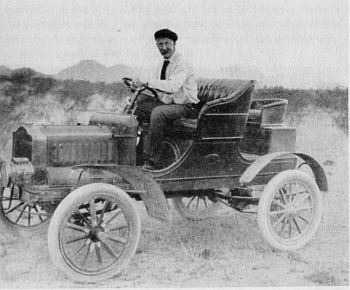Meet Tumamoc's Pioneers & Heroes
Frederick Coville
Volney Spalding
Daniel MacDougal
William Cannon
Burton Livingston
Godfrey Sykes
Francis Lloyd
Burt Bovee
Forrest Shreve
Effie Spalding
Ray Turner
Paul Martin
| |

Godfrey Sykes at the wheel of an early Lab field vehicle. There were no roads and he found himself constantly repairing the fleet. He made the left-front wheel of this workhorse from assorted bits and pieces. |
Godfrey Sykes was born May 25, 1861, in West Yorkshire, England. In 1879, he and his brother decided to cow-punch their way across the American West. In 1886, he, his wife and his brother settled in Flagstaff where they presided over a sort of intellectual drinking club called the Busy Bees. Not long before the Desert Lab was founded, who should join them but Daniel T. McDougal, one of the two founders of the Carnegie Desert Lab. Sykes and McDougal really hit it off. In 1906, McDougal hired his good friend to supervise the new building and infrastructure projects that he was undertaking on the Hill. Godfrey Sykes (1906) supervised the construction of our 5-mile long restoration ecology fence, and (1907) the eastern half of the main lab building, and (1914) the chemistry laboratory that sits across the road. He also supervised the construction of our boathouse at the base of the hill. |
|
In 1907, the Desert Laboratory wanted to observe and record the process of re-vegetation at the edge of the Salton Sea in California. But they needed a boat to do it. Godfrey Sykes removed himself to the shore of the Salton Sea, taking along only some light camping gear and a box of carpenter's tools. Pretty soon he had built a stable skiff with a sprit-sail, and the studies commenced. They lasted fifteen years, during which Sykes built other boats in the Boathouse, some kayaks and one with motor power. He mapped the region and studied the accumulation of silt in the delta of the Colorado River. He was honored for his scientific work by the Royal Geographical Society of England and the American Geographical Society. Godfrey Sykes could figure out how to do anything, and do it superlatively. When he and his wife decided to give up living in a tent at the base of Tumamoc Hill, he taught himself stone masonry and built his family a home. The result still stands at the base of the Hill. During World War I, Sykes helped to develop the gas mask used by British Empire troops throughout the war. In return, he received full membership in the British Society of Mechanical Engineers. But the skill he acquired as an 83-year old man stands apart. Having lost his leg, he fashioned a wooden leg for himself from Ponderosa pine. Then he redesigned and remade his automobile so he could drive using only one foot pedal. Godfrey Sykes died in Tucson at age 87 on December 23, 1948. | |